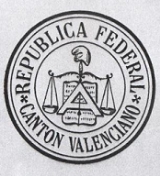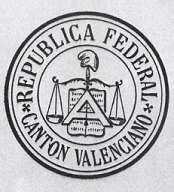
Cantonalism
Encyclopedia
Cantonalism, mainly prevalent in late 19th century and early 20th century Spain
, is an insurrectionary movement which aims to divide the nation state into almost independent cantons.
It is in favor of federalism
with a radical character (including redistribution of wealth, improvement of the working classes etc.), its goal is to establish a confederation of towns or cities (cantons) as a federation of independent units. It resembles in some ways to the Greek
polis
. Cantonalism was predominantly a phenomenon of the petty bourgeoisie
, but also had a great influence on the nascent labor movement, and constituted a precedent for anarchism in Spain
.
 In Spain
In Spain
there have been two eras when cantonalism has come to the forefront.
, on July 12 of 1873 in Cartagena, when the insurgency took place with the name Cantonal Revolution. In the following days it spread through many regions including, Valencia
, Andalusia
(especially Granada
), Cartagena (which endured for several months the attack of Nicolás Salmerón) and in the provinces of Salamanca
and Ávila
, all of them in places that came to articulate cantonalism. It can also be noted, the attempt to establish cantons took place in Extremadura
, Coria
, Herve
and Plasencia
. Pi y Margall, seeing that cantons declared independent by the tardiness of the taxation of improvements, resigned from his post to be succeeded by Salmerón.
, which was developed during the Spanish Civil War
and the so-called Spanish Revolution
, when for five months committees were established. Dozens of municipal and district councils of autonomous power, independent from the state
, with their own notes and coins, were established. In some cases, independent municipalities or provinces communicated this decision to the League of Nations
. Asturias
and Leon
declared sovereignty in late August 1937 with the formation of the .
Spain
Spain , officially the Kingdom of Spain languages]] under the European Charter for Regional or Minority Languages. In each of these, Spain's official name is as follows:;;;;;;), is a country and member state of the European Union located in southwestern Europe on the Iberian Peninsula...
, is an insurrectionary movement which aims to divide the nation state into almost independent cantons.
It is in favor of federalism
Federalism
Federalism is a political concept in which a group of members are bound together by covenant with a governing representative head. The term "federalism" is also used to describe a system of the government in which sovereignty is constitutionally divided between a central governing authority and...
with a radical character (including redistribution of wealth, improvement of the working classes etc.), its goal is to establish a confederation of towns or cities (cantons) as a federation of independent units. It resembles in some ways to the Greek
Ancient Greece
Ancient Greece is a civilization belonging to a period of Greek history that lasted from the Archaic period of the 8th to 6th centuries BC to the end of antiquity. Immediately following this period was the beginning of the Early Middle Ages and the Byzantine era. Included in Ancient Greece is the...
polis
Polis
Polis , plural poleis , literally means city in Greek. It could also mean citizenship and body of citizens. In modern historiography "polis" is normally used to indicate the ancient Greek city-states, like Classical Athens and its contemporaries, so polis is often translated as "city-state."The...
. Cantonalism was predominantly a phenomenon of the petty bourgeoisie
Petite bourgeoisie
Petit-bourgeois or petty bourgeois is a term that originally referred to the members of the lower middle social classes in the 18th and early 19th centuries...
, but also had a great influence on the nascent labor movement, and constituted a precedent for anarchism in Spain
Anarchism in Spain
Anarchism has historically gained more support and influence in Spain than anywhere else, especially before Francisco Franco's victory in the Spanish Civil War of 1936–1939....
.
Spain

Spain
Spain , officially the Kingdom of Spain languages]] under the European Charter for Regional or Minority Languages. In each of these, Spain's official name is as follows:;;;;;;), is a country and member state of the European Union located in southwestern Europe on the Iberian Peninsula...
there have been two eras when cantonalism has come to the forefront.
First period
The first of these events took place during the First Spanish RepublicFirst Spanish Republic
The First Spanish Republic was the political regime that existed in Spain between the parliamentary proclamation on 11 February 1873 and 29 December 1874 when General Arsenio Martínez-Campos's pronunciamento marked the beginning of the Bourbon Restoration in Spain...
, on July 12 of 1873 in Cartagena, when the insurgency took place with the name Cantonal Revolution. In the following days it spread through many regions including, Valencia
Valencia (province)
Valencia or València is a province of Spain, in the central part of the Valencian Community.It is bordered by the provinces of Alicante, Albacete, Cuenca, Teruel, Castellón, and the Mediterranean Sea...
, Andalusia
Andalusia
Andalusia is the most populous and the second largest in area of the autonomous communities of Spain. The Andalusian autonomous community is officially recognised as a nationality of Spain. The territory is divided into eight provinces: Huelva, Seville, Cádiz, Córdoba, Málaga, Jaén, Granada and...
(especially Granada
Granada
Granada is a city and the capital of the province of Granada, in the autonomous community of Andalusia, Spain. Granada is located at the foot of the Sierra Nevada mountains, at the confluence of three rivers, the Beiro, the Darro and the Genil. It sits at an elevation of 738 metres above sea...
), Cartagena (which endured for several months the attack of Nicolás Salmerón) and in the provinces of Salamanca
Salamanca (province)
Salamanca is a province of western Spain, in the western part of the autonomous community of Castile and León. It is bordered by the provinces of Zamora, Valladolid, Ávila, and Cáceres; and by Portugal....
and Ávila
Ávila (province)
Ávila is a province of central-western Spain, in the southern part of the autonomous community of Castile and León. It is bordered on the south by the provinces of Toledo and Cáceres, on the west by Salamanca, on the north by Valladolid, and on the east by Segovia and Madrid. Ávila has a...
, all of them in places that came to articulate cantonalism. It can also be noted, the attempt to establish cantons took place in Extremadura
Extremadura
Extremadura is an autonomous community of western Spain whose capital city is Mérida. Its component provinces are Cáceres and Badajoz. It is bordered by Portugal to the west...
, Coria
Coria, Cáceres
Coria is a municipality located in the province of Cáceres, Extremadura, Spain, with some 12,900 inhabitants as of 2009.-History:Coria was taken twice during the Reconquista, firstly after 1085. It was lost to the Almoravids just after 1109 and unsuccessfully besieged in 1138...
, Herve
Herve
Herve is a Walloon municipality of Belgium in Province of Liège. On January 1, 2006 Herve had a total population of 16,772. The total area is 56.84 km² which gives a population density of 295 inhabitants per km²....
and Plasencia
Plasencia
Plasencia is a walled market city in the province of Cáceres, Extremadura, Western Spain. , it had a population of 41,447.Situated on the bank of the Jerte River, Plasencia has a historic quarter that is a consequence of the city's strategic location along the Silver Route, or Ruta de la Plata...
. Pi y Margall, seeing that cantons declared independent by the tardiness of the taxation of improvements, resigned from his post to be succeeded by Salmerón.
Second period
The second period when this phenomenon took place, despite not being in an ideological manner as above, corresponds to the end of the Second Spanish RepublicSecond Spanish Republic
The Second Spanish Republic was the government of Spain between April 14 1931, and its destruction by a military rebellion, led by General Francisco Franco....
, which was developed during the Spanish Civil War
Spanish Civil War
The Spanish Civil WarAlso known as The Crusade among Nationalists, the Fourth Carlist War among Carlists, and The Rebellion or Uprising among Republicans. was a major conflict fought in Spain from 17 July 1936 to 1 April 1939...
and the so-called Spanish Revolution
Spanish Revolution
The Spanish Revolution was a workers' social revolution that began during the outbreak of the Spanish Civil War in 1936 and resulted in the widespread implementation of anarchist and more broadly libertarian socialist organizational principles throughout various portions of the country for two to...
, when for five months committees were established. Dozens of municipal and district councils of autonomous power, independent from the state
State (polity)
A state is an organized political community, living under a government. States may be sovereign and may enjoy a monopoly on the legal initiation of force and are not dependent on, or subject to any other power or state. Many states are federated states which participate in a federal union...
, with their own notes and coins, were established. In some cases, independent municipalities or provinces communicated this decision to the League of Nations
League of Nations
The League of Nations was an intergovernmental organization founded as a result of the Paris Peace Conference that ended the First World War. It was the first permanent international organization whose principal mission was to maintain world peace...
. Asturias
Asturias
The Principality of Asturias is an autonomous community of the Kingdom of Spain, coextensive with the former Kingdom of Asturias in the Middle Ages...
and Leon
León (province)
León is a province of northwestern Spain, in the northwestern part of the autonomous community of Castile and León.About one quarter of its population of 500,200 lives in the capital, León. The weather is cold and dry during the winter....
declared sovereignty in late August 1937 with the formation of the .
External links
- Cartagena-Cantón-1873, a group making a historical reenactmentHistorical reenactmentHistorical reenactment is an educational activity in which participants attempt torecreate some aspects of a historical event or period. This may be as narrow as a specific moment from a battle, such as the reenactment of Pickett's Charge at the Great Reunion of 1913, or as broad as an entire...
of the canton of Cartagena.

